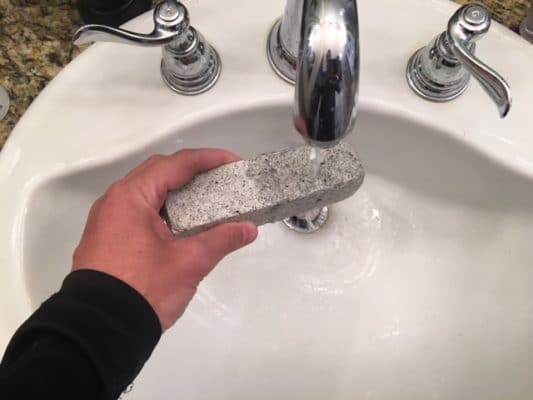Pumice stones are a useful tool to get rid tough buildup in toilet bowls. They are natural, chemical-free, and inexpensive – what’s not to like?
Pumice stones are more than just a tool for toilets, they are used for tough stains everywhere (like tile in showers and swimming pools). The Romans used pumice stones to remove hair and some people still use them for the bottom of their feet!
I’ve grown up using these volcanic rocks and I’ve learned a few lessons along the way. There are a few tricks to make sure your pumice stone works without damaging your toilet.
In this article I’ll share what pumice stone is and how to use it in your toilet. Many people are curious if pumice stone will damage or scratch their toilet. I’ll tell you how to avoid toilet damage.
What Is Pumice Stone
A pumice stone is a volcanic rock (how cool is that?). The shape and texture of the rock is created because of a rapid cooling process and reduction in pressure that occurs when the rock is ejected from a volcano.
The depressurization results in thousands of tiny air bubbles in the rock. This is why pumice stone is so lightweight.
The pumice stone’s structure is made up of volcanic glass and sometimes crystals. The sandpaper-like texture and lightweight characteristics make it perfect tool to and because it’s so hard it does a great job at scraping off any type of build up or stains.
If you need a pumice stone there are plenty of cheap options on Amazon.
The size of pumice stone varies but what we see in stores have been cut and shaped into small pieces that are perfect for cleaning (read more about the various uses of pumice stone).
How To Use A Pumice Stone To Clean A Toilet
I grew up using pumice stones and learned a few important lessons early on. I remember watching my father work his way around the edge of the swimming pool every summer as he rubbed and shined the tile.
It was a week-long process but in the end the tile looked like new and the white mildew was removed. Sometimes he asked me to help out, and I did begrudgingly.
He told me taught me two things about using the pumice stone.
-
Rule #1: Always get the pumice stone wet first
You want a wet pumice stone so it can slide on the toilet bowl. A dry pumice stone will provide more friction and has a greater chance of doing damage.
Simply run the pumice stone under the faucet for a few seconds and you’re ready to go.
-
Rule #2: There’s no need to press hard
Most people think they have to press as hard as possible with a pumice stone to remove the buildup. This isn’t true.
Pumice stone works a lot like sandpaper. Rubbing for 30 seconds or more with light pressure usually does the trick and avoids the need for hard pressure.
-
Rule #3: Wear gloves if you have sensitive hands
If you have a stubborn stain in your toilet you might be holding the pumice stone for a while. You’ll need a good grip and tough hands.
It’s wise to wear gloves to avoid bacteria from the toilet, however, just holding the pumice stone can also scrape the superficial layers of the skin. Wearing gloves will allow you to get your hand farther into the toilet bowl as well.
-
Rule #4: For toilets, prepare the toilet with vinegar or cleaning solution
When cleaning my toilet I always start with vinegar and a toilet brush. The pumice stone is saved for the last step of cleaning if I find stubborn stains.
I find that vinegar, if left for a few hours, does a great job of loosing up build up. Then I can use the pumice stone to remove the ring in the toilet bowl (no chemicals needed).
Where On Toilet Can I Use Pumice Stone (Not On The Seat!)
In order to know where to use pumice stone you need to know the parts of the toilet. The main parts of the toilet are the tank and bowl. Most household toilets (not all) are made from porcelain.
Porcelain is white, hard, and a natural substance that holds up well over time. The seat and lid are an attachment and usually made from plastic or wood.
Porcelain is very hard and pumice stone won’t damage the bowl or the tank. It’s important to follow Rule #2 and not press too hard with the pumice stone.
Light pressure and repetitive movement should remove a pesky toilet bowl ring. You’ll notice some of the pumice stone grinds off and will fall to the bottom of the toilet – don’t worry it will flush when you’re finished.
The plastic and wood found on your toilet seat should never be rubbed with a pumice stone. Both materials are soft and will scratch or chip.
Pumice Stone Price
Pumice stones are affordable and easily found at home improvement stores or online (I like this one with a handle on Amazon). They usually cost around 10 dollars depending on the brand and style.
Most homes have a pumice stone lying around the house but if you don’t it’s smart to buy one. They are useful in the shower for calluses on your feel and the shower tiles.
Once you have a pumice stone it will last a long time; often they last multiple years!
Conclusion
A pumice stone is one of the most useful tools for the bathroom and it works particularly well in the toilet for rings around the bowl.
If you haven’t used a pumice stone before it might be worrisome to think about damage it could do to your toilet. After all, pumice is a very hard, abrasive stone.
Much like tile, porcelain is a very hard substance and pumice won’t damage your toilet. However you’ll want to take precautions to 1) wet the stone before using, 2) not press hard against the bowl and 3) wear gloves to protect your hands.
If possible, use a natural cleaner like vinegar, baking soda, or citric acid to loosen up the buildup before using the stone. Remember not to use pumice stone on your toilet seat because it’s likely made from plastic or wood.
Using a pumice stone won’t damage or scratch your toilet but make sure you use it properly in the correct areas of the toilet. A pumice stone is my go-to tool for hard water stains and mildew build up.
I appreciate the fact that it’s natural and chemical-free. Thanks for reading another one of my articles.
Check out the homepage at Toilet Travels for more information on toilets!
